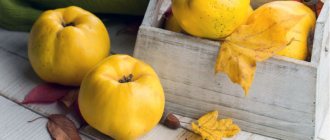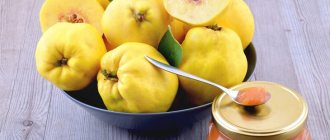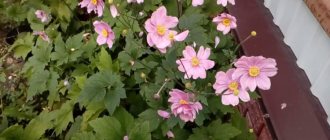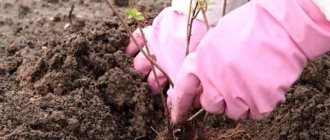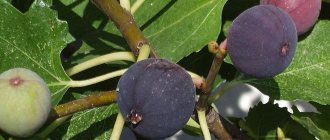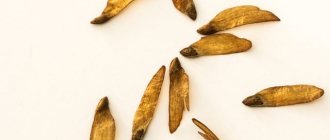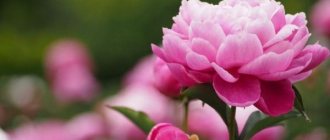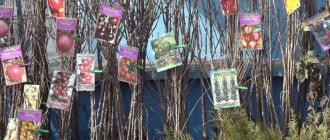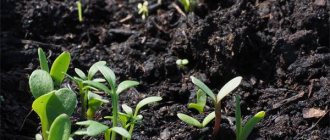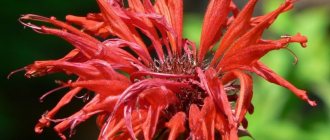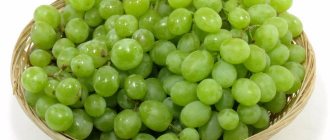Author: Natalya Category: Garden plants Published: February 14, 2019Republished: February 14, 2019Last edits: January 13, 2021
- Growing conditions
- Reproduction by root suckers
- Beneficial features
Japanese Chaenomeles (lat. Chaenomeles japonica), or Japanese quince , is a species of flowering dicotyledonous plants of the Chaenomeles genus of the Rosaceae family. The species is native to Japan, although the plant is also widely grown in China and Europe. The generic name is literally translated from Greek as “split an apple.”
Planting and caring for chaenomeles
- Flowering: abundant, in May-June for three weeks.
- Planting: in spring, before sap flow begins, and in autumn, during leaf fall.
- Lighting: bright sunlight.
- Soil: rich in humus, light – sandy loam, loamy or soddy-podzolic, slightly acidic – pH 6.5.
- Watering: after planting - frequent and plentiful, especially during dry periods. In the future, regular but moderate.
- Fertilizing: after planting, fertilizing will be needed only after a year: in the spring, a bucket of compost, 100 g of potassium fertilizer and 300 g of superphosphate are added to the tree trunk circle. In summer, quince is fertilized with ammonium nitrate or mullein.
- Pruning: sanitary cleaning and formative pruning are carried out in early spring, before sap flow begins. When the bush reaches eight to ten years of age, it undergoes anti-aging pruning.
- Reproduction: seeds, root suckers, grafting and cuttings.
- Pests: scale insects and spider mites.
- Diseases: cytosporosis and ramulariasis.
Read more about growing Chaenomeles below.
Further care after transplantation
After successful transplantation and adaptation of the plant in a new location, the shrub is provided with standard care. Chaenomeles needs it for normal growth and abundant fruiting, strengthening immunity to diseases and pests, and also helps the plant survive the winter safely. The key elements of crop care are watering and fertilizing.
Important! After watering or rain, it is recommended to remove weeds around the chaenomeles, as well as to superficially loosen the soil in the tree trunk circle. This improves access of water and air to the roots of the bush.
Watering
Japanese quince does not respond well to waterlogged soil - under such conditions the risk of fungal infections and root rot increases. But with a significant lack of moisture, the plant bears fruit poorly and begins to dry out.
To provide the bush with enough water, watering is carried out according to the following rules:
- additional irrigation is required only when there is a long absence of rain;
- watering is carried out at intervals of about 30 days, but during hot and dry weather the soil around the bush is moistened every 2-3 weeks;
- water consumption rate is about 10–15 liters for each specimen;
- The last watering is carried out around mid-October - the purpose of this procedure is to saturate the roots with moisture to prepare the plant for wintering.
Feeding and fertilizer
If, during the preparation of a planting hole in a new area, the gardener added fertilizers to it, then the next fertilizing can be done only after 1-2 years.
We advise you to find out how to properly transplant viburnum to a new location.
For an adult shrub, this procedure is carried out according to the following rules:
- at the beginning of the flowering period, 50–60 g of ammonium nitrate or ammonium sulfate is added to the tree trunk area, mixing the substance with the soil;
- 2 weeks after harvesting the fruits, the bush is fed with a ready-made complex fertilizer for berries and fruit crops, containing potassium and phosphorus (for example, Agricola, Kemira-Lux) - when preparing the solution, follow the instructions indicated on the package;
- once every 3-4 years - the procedure is performed in early spring, spending 2-3 kg of humus per plant.
The procedure for transplanting Japanese quince to a new place requires the gardener to be careful and follow a certain algorithm of actions. But with the help of the recommendations presented in the article, you can perform this procedure correctly, and then provide the shrub with proper care. As a result of this, chaenomeles will become a real decoration of the site and will delight you with regular fruiting.
Botanical description
Japanese quince chaenomeles is a densely leafy shrub up to 3 m high with a dense crown of the same diameter. Young shoots of the plant are green, scaly-felt, then they become bare and black-brown. The leaves of Japanese quince are spatulate or obovate, narrowed towards the base, with blunt-toothed edges, 3 to 5 cm long and 2 to 3 cm wide. When young they are bronze, but the mature leaves of the plant are dark green. Pink, scarlet-red or orange flowers up to 5 cm in diameter are collected in 2-6 pieces in corymbose inflorescences. The round-shaped yellow-green edible fruits of Japanese quince with a diameter of up to 6 cm ripen by mid-autumn.
Planting and caring for quince in open ground
The plant has been in cultivation since 1874. The Japanese quince bush grows very slowly. The plant is thermophilic, but despite this it is able to withstand frosts down to -30 ºC, although at this temperature its annual shoots and flower buds that are above the snow level freeze slightly. Therefore, Japanese quince in Siberia may not bloom as luxuriantly as Japanese quince in the Moscow region or Japanese quince in the Urals. However, this crop is grown even in places with harsh climates.
Chaenomeles - Japanese quince: varieties and varieties
Chaenomeles or Japanese quince is classified in the genus of the same name.
The natural habitat of quince is on the Japanese islands, China and Korea, where the plant lives on moist, humus-rich soils. Decorative quince is represented by deciduous or evergreen shrubs that grow up to 1 meter, or trees that reach 3 m.
Decorative quince
The branches of the plant are densely covered with beautiful shiny leaves of bright green color. The edge of the leaf blade is jagged, large stipules have a serrate shape. The branches of the plant are flexible, arched, and decoratively curved. Many species and varieties of Chaenomeles have sharp spines up to 2 cm long on their shoots. Sometimes there are no leaves on the branches, and the shoots are entirely covered with prickly spines.
The root system of the plant is taprooted, the roots are powerful and go deep into the ground. The plant is not afraid of drought: long roots are able to reach aquifers at significant depths. Transplanting an adult plant presents a rather serious problem - it is often impossible to replant a tree without damaging the root system.
The plant can boast of being particularly decorative during flowering. Take a look at the photo of a blooming Japanese quince: flowers with a diameter of 3-5 cm, sheer charm. The standard color of Chaenomeles flowers is red-orange, but there are varieties with pink and white colors. Individual flowers are collected in brushes with an even number of flowers (usually 2-6 pieces). The varieties with double flowers that completely cover the curved graceful branches look especially decorative.
Quince bush
This amazingly beautiful plant also bears fruit. At the beginning of autumn, small fruits ripen, densely covering the branches. The color of the fruit, depending on the variety, can be green, yellow or orange. The fruits remain on the branches until frost, which does not affect the quality of the fruit. Young plants begin to bear fruit from the 3rd year. The photo shows different types of Chaenomeles fruits, which resemble a quince or a small apple.
In the recent past, the plant was valued only for its decorative appearance. Modern breeding work is aimed at developing fruit varieties without thorns and thorns with improved fruit qualities and taste. The fact is that the fruits contain a record high percentage of vitamin C, which is preserved even when canned.
Japanese quince fruits
The variety of types of Japanese quince includes varieties:
- Chaenomeles Mauleya (low quince);
- Chaenomeles Cathayan;
- The quince is wonderful.
Planting Japanese quince in open ground
When to plant
Planting and caring for Japanese quince follows the general rules for growing garden shrubs. It is better to plant chaenomeles in open ground in the spring, before sap flow begins. Autumn planting of the plant is also possible, but it is less desirable, since the heat-loving chaenomeles may not have time to take root in a new place before the onset of frost. The best planting material is two-year-old Japanese quince seedlings with a closed root system, which are watered abundantly before planting. For seedlings with an open root system, you should carefully examine the roots, if necessary, soak them in water for several hours, and then remove rotten, dry and damaged roots.
- Oregano: cultivation, types and varieties
How to plant
Chaenomeles is planted in well-lit areas, since in the shade it develops worse and does not bloom as profusely. The plant prefers soil rich in humus, but light - soddy-podzolic, loamy or sandy loam with a slightly acidic reaction (pH 6.5). Japanese quince tolerates peat soils less well. It is advisable to allocate a place for it, protected from winds and drafts, on the south or southwest side of the house. Keep in mind that Japanese quince does not tolerate transplantation very well, and it will have to grow for 50-60 years in the place you choose.
The soil for spring planting needs to be prepared in the fall: cleared of weeds, dug up with the addition of leaf soil and sand. For digging, peat manure compost is also added at the rate of 10 kg per m² and 40 g of phosphorus and potassium fertilizers per the same unit of area. For a single planting, dig a hole with a diameter of 50 cm and a depth of 50-80 cm, and also prepare a soil mixture by adding 1-2 buckets of humus, 500 g of ash, 300 g of superphosphate and 30 g of potassium nitrate to the fertile soil from the top layer removed when digging the hole. . In group planting, plants are placed at a distance of 80-150 cm from each other, and when planting a hedge, an interval of 50-60 cm is sufficient. If you intend to get a fruit harvest by autumn, then plant 2-3 different varieties nearby. One bush of Japanese quince produces an average of about 2 kg of fruit, but there are also productive years when you can harvest up to 5 kg from one plant.
Planting and caring for an apple tree in the garden
On the day of planting, a mound of soil mixture is poured into the center of the hole and the seedling is placed on it so that the root collar is flush with the surface. The remaining space of the pit is filled with fertile soil mixture. After planting, the surface is compacted and watered abundantly. The shoots of the seedling are shortened to 15-20 cm.
Reproduction by root suckers
Japanese quince tends to produce numerous root suckers. Due to them, the bush gradually spreads in all directions. At 20 years of age, it covers an area of up to 2 m2. Due to the overgrown shoots, the root system of Japanese quince is able to firmly hold the soil on a slope. It is so branched and elastic that if there is a desire to completely get rid of an adult bush, it will not be so easy to do.
When digging up root shoots, shoots 10-15 cm long and 0.5 cm thick with a well-developed root system are selected. From one bush you can get no more than 5-6 root shoots. They are planted vertically, watered regularly, maintaining sufficient soil moisture, then mulched around the bush with humus, wood chips or shavings. However, the disadvantage of this method of propagation is that some offspring growing from the taproot have a poorly developed root system, and the resulting seedlings have to be grown. It has been noticed that at first such seedlings even produce smaller fruits than usual.
Japanese quince care
Growing conditions
Growing and caring for Japanese quince is unlikely to seem like a difficult task. During the first time after planting, quince needs regular watering, this is especially important during dry periods. After watering, the soil around the plant is carefully loosened to a depth of 8-10 cm. At the same time, weeds should be removed. To retain moisture in the soil as long as possible, the trunk circle of Japanese quince, the size of the crown projection, is mulched with a layer of peat, pine nut shells, crushed bark or sawdust 3-5 cm thick.
Once you have applied fertilizer when planting in a hole, the plant will not need it for at least a year. From the second or third year of life, Japanese quince is fed with mineral and organic fertilizers in the spring: a bucket of compost, 300 g of superphosphate and 100 g of potassium fertilizer are poured into the trunk circle of each bush. During the summer, liquid fertilizing with a solution of ammonium nitrate (20 g of fertilizer for each bush) or mullein (3 liters of a ten percent solution for each plant) will not be superfluous.
In late autumn, you need to prepare Japanese quince for winter. The tree trunk circle is securely covered with a thick layer of dry foliage or spruce branches. Seedlings or rooted cuttings are covered with spunbond or lutrasil, and low-growing compact bushes are covered with wooden boxes or cardboard boxes.
Diseases and pests
Japanese quince gets sick in exceptional cases, when there is practically no care for it or under the influence of natural disasters, for example, in cool rainy weather, which provokes the activity of fungal infections, the development of necrosis and spotting. At this time, the plant can be affected by cytosporosis or ramularia: the leaves of the plant become brown, dry, and the color of the Chaenomeles bark changes. These diseases must be controlled with copper-based antifungal chemicals, but diseased branches and shoots must be removed and burned before treatment.
Among the pests for Japanese quince, scale insects and spider mites are dangerous, the appearance of which is easier to prevent than to get rid of them for a long time. The first preventive spraying with an acaricidal drug (Aktara, Aktellik, Karbofos and the like) is carried out before the buds open, and then re-treatment may not be necessary.
Proper planting of Japanese quince
Planting Japanese quince is best timed to coincide with the warm season; mid-spring is perfect for this purpose. Young seedlings can be planted in separate holes and trenches (planting hole depth - up to 40 cm, width - 50 x 50 cm).
To ensure that the plant actively blooms and bears fruit, plant it in a sunny area.
The plant is undemanding to soil, but cannot develop without regular dosed watering. Overwatering of the root system is also detrimental to a young tree, as is keeping it dry. Young Chaenomeles plants react negatively to feeding with organic fertilizers in the first three years of their life. Do not apply fertilizers during planting and during the further growth of the tree.
Advice! When planting Japanese quince, it is important to take into account the acidity of the soil - the plant does not tolerate salinity and hard calcareous soils.
If the depth of groundwater in the planting area is insignificant, it is necessary to provide reliable drainage and protect the roots of the young bush from getting wet.
Advice! It is very important not to bury the root collar of the plant when planting.
Quince tolerates partial shade, but this arrangement leads to reduced flowering and a low percentage of fruit production. When choosing a place to plant Japanese quince, it is necessary to provide maximum illumination of the crown. A young tree must be protected from direct wind. It is best to place quince plantings under the protection of buildings.
Pruning Japanese quince
The Japanese quince shrub tolerates pruning well, and this makes it a most valuable plant for ornamental gardening. To avoid injury, wear thick gardening gloves when pruning.
Planting and caring for pears in the garden
In the spring, sanitary cleaning of the bush is carried out: shoots frozen in winter, dry, damaged and improperly growing are removed. Places of cuts thicker than 7 mm are treated with garden varnish. Formative pruning is also carried out in the spring, before sap flow begins, but the crown of the plant begins to form at the age of four to five: to prevent the bush from growing wider and thickening, part of the root shoots are cut out annually, leaving only 2-3 young offspring. The most valuable are shoots located horizontally at a height of 20-40 cm from the ground. Shoots growing vertically or creeping along the ground must be removed.
When the bush reaches eight to ten years of age and the annual growth of shoots decreases to 10 cm, it is necessary to carry out anti-aging pruning. First, the bush is thinned out, leaving only 10-15 strong shoots. Since the main fruiting occurs on three to four year old branches, you need to gradually cut out branches that are five or more years old, replacing them with young shoots from the root shoots.
Diseases and pests of Chaenomeles
The plant is highly resistant to diseases, but the overall development of Japanese quince is negatively affected by winter frostbite of the trunk and branches, which opens the way for all kinds of infections.
Rust on quince
Very rarely the plant is attacked by aphids. Getting rid of the pest is not particularly difficult - trees affected by pests are treated with special preparations against aphids, and at the same time the garden is treated against the invasion of garden ants.
Sometimes flower gall midges attack quince.
Japanese quince in landscape design
Reproduction of Chaenomeles
Japanese Chaenomeles propagates by seeds, cuttings, root suckers and grafting.
Reproduction by root suckers
Chaenomeles produces abundant root shoots, due to which the bush gradually grows in width and at the age of twenty occupies an area of about 2 m². You can dig up and plant root suckers 10-15 cm long and about 5 mm thick with well-developed roots. One plant can produce 5-6 such offspring. The planted shoots are regularly watered, and the surface of the soil around the shoots is mulched with shavings, wood chips or humus. The disadvantage of this method of propagation is that the shoots growing from the tap root still have an underdeveloped root system, and they have to be grown.
- Aspidistra in the photo with species names
Growing from seeds
The generative method of propagation of Chaenomeles is the most reliable. Fresh Japanese quince seeds, with a germination rate of about 80%, are sown in the ground before winter, and in the spring they sprout vigorously. Two-year-old seedlings form long tap roots, so they need to be planted in a permanent place as early as possible.
If you were unable to sow the seeds before winter, put them in the refrigerator for stratification, where they will remain in a bag of wet sand for 2-3 months. In the spring, as soon as they hatch, they can be sown in the ground.
Propagation by cuttings
The advantage of propagating Japanese quince by cuttings is that this method preserves the varietal properties of the plant. Green cuttings are cut in dry, hot weather in early June. Each cutting should have 1-2 internodes, and on the lower cut there should be a heel (a piece of last year’s wood) up to 1 cm long. For successful rooting of cuttings, it is necessary to use growth stimulants - indolylbutyric acid or Kornevin. The cuttings are immersed with the lower cut into a substrate consisting of three parts sand and one part peat, at an angle of 45º according to a 7x5 cm pattern and kept under a transparent cap at a temperature of 20-25ºC. The roots of the cuttings grow in 35-40 days, then the cuttings are planted in a permanent place.
Chaenomelis grafting
Japanese quince is grafted in May using the improved copulation method. A varietal cutting is taken as a scion, and a seedling of the main species or other rosaceous crops is used as a rootstock. Eye grafting is carried out in July-August, during the second sap flow: a bud (eye) with a piece of bark (scutellum) is cut off from the middle part of the varietal shoot with a sharp knife. Then a T-shaped cut in the bark is made on the bark of the rootstock, its edges are folded back and a shield with a peephole is inserted under them. Then the bent edges of the bark of the T-shaped cut are pressed against the shield and the scion is tightly tied in this place so that the eye itself is not covered with a bandage. After 3-4 weeks, if you did everything correctly, the eye should take root. If next spring the new bud sprouts, the bandage is removed.
Propagation by seeds
The easiest and most reliable way to propagate Chaenomeles japonica is by seeds. When ripe fruits are prepared for processing and the core with large brown seeds is cleaned out, it can not be thrown away, but used for sowing. The seeds are removed and sown in the ground immediately in the fall, that is, “before winter.” All of them have high germination rates (up to 80%), producing dense shoots already in the spring, regardless of the quality of the prepared soil. If the crop cannot be sown within this time frame, then the seeds will have to be stratified. To do this, they are kept for 2-3 months in moistened sand at a temperature of +3+5°C. After they hatch, they are transferred to the ground in the spring. Two-year-old seedlings develop a long tap root, so careless replanting can cause damage leading to the death of seedlings. To save seedlings, they should be planted in a permanent place as early as possible.
Varieties of Japanese quince
There are so many varieties of Japanese quince that you could write a separate article about them, so we will introduce you only to the most popular of them:
- Nikolai is a low-growing and thornless variety of Ukrainian selection with a spreading crown, orange-red flowers and slightly lumpy round yellow fruits weighing 50-80 g;
- Gaillardi is an ornamental plant with salmon-orange flowers;
- Malardi is an ornamental bush with pink flowers with a white border along the petals;
- Likhtar is also a Ukrainian non-thorny variety up to 1 m high, characterized by winter hardiness. The flowers are orange-red, the fruits are yellow-green, slightly lumpy, round, weighing up to 100 g;
- Papella is an ornamental plant with yellow flowers with a pink border;
- Fascination is a Dutch variety up to 1 m high with thorny branches, large red flowers, round or ovoid green fruits weighing 50-60 g;
- Merlozi is a Belgian variety up to 2 m high with relatively prickly erect branches, large white flowers with pink stripes and irregular pear-shaped green fruits weighing 60-80 g;
- Umbilicata is a Japanese variety up to 2 m high with erect, relatively prickly branches, pink-red flowers and spherical fruits weighing up to 90 g;
- Crimson End Gold is an American selection variety up to 1 m high with thorny spreading branches, medium-sized dark red flowers and greenish-yellow ovoid fruits weighing from 40 to 80 g with blush and thin skin;
- Simoni is a French variety 1-1.5 m high with spiny spreading branches, large dark red flowers and small, greenish-yellow ovoid fruits weighing 40-50 g;
- Nivali is a French variety up to 2 m high with dense prickly branches, medium-sized white flowers and yellow round fruits weighing up to 80 g.
In addition to those described, such varieties of chaenomeles as Toyo Nishiki, Snow Queen, Rubra, Vitamin, Ellie Mossel, Pomaranchevy, Karavaevsky, Kalif, Nika, Citrine, Fragrant, Krasnoplodny and others are popular.
Description and varieties
Chaenomeles includes several species that differ in plant height, fruit size, and growing area. They are united by common characteristics, such as beautiful flowering and the fragrant smell of fruits.
Chaenomeles beautiful and Chaenomeles japonica are two popular species. In the spring, when flowering, the shrub is highly decorative; its flowers have a beautiful red color. The fruits differ in size, since in Chaenomeles japonica they are the size of an egg, and in Chaenomeles japonica they are the size of an apple. Hanomeles japonica can grow even at the latitude of the Baltic states, and Hanomeles beautiful is common in the south.
Chaenomeles, as a genus, includes a total of 3 main species and hybrids, all of Asian origin. These are either deciduous crops or partially evergreen. Often the shrub has the form of small trees that bear fruit in the autumn. The species C. Cathayensis (Chinese quince) has a height of up to 3 meters, large leaves and spines. The flowers are pink or even white, large fruits up to 6 cm. Frost resistance is insufficient for growing in northern latitudes.
Hybrids with pink, orange and double flowers have been bred using a selection method. The fruits differ in shape and size, more early ripening or late ripening. But winter hardiness was never developed to the same extent as in Japanese Chaenomeles. The species Chaenomeles Mauleya (or Chaenomeles japonica low) has a bush height of only 1 meter. Its fruits ripen in September.
There are up to 500 varieties of Japanese quince.
Japanese quince in landscape design
Chaenomeles is rightfully considered one of the most beautiful ornamental shrubs: rich green leaves shimmering in the rays of the sun, massive bright flowers of various colors, amazing yellow-orange or greenish-yellow fruits that simultaneously resemble apples and pears... The main advantage of the plant is that that it remains attractive throughout the growing season, from spring to late autumn. And since the lifespan of the plant is several decades, the ornamental Japanese quince will decorate your garden for almost your entire life.
In landscape design, not only tall varieties of Chaenomeles are used: low Japanese quince, reaching a height of no more than 1 m, with arched branches covered in spring with a mass of flowers, is also incredibly attractive.
Chaenomeles japonica is widely used to form rocky gardens and hedges. It is grown both as a solo plant in a rock garden or on a spacious lawn, and in groups forming artistic or geometric compositions. A popular method of growing Japanese quince on a high trunk is done by grafting its cuttings onto a wild pear or mountain ash.
The plant goes well with dwarf spruce, slate pine and varietal thuja. Blooming Japanese quince looks spectacular next to daffodils and Carpathian bells.
What is Japanese quince?
Small deciduous trees or shrubs belonging to the genus Chaenomeles of the Rosaceae family. Wild representatives are found in China and Japan. In Europe and North America, these plants have been known for more than two hundred years due to the magnificent flowering and ability of Chaenomeles to form dense natural borders. In the Soviet Union, Japanese quince under the name quince became widespread in the Baltic states, especially in Latvia.
By mistake, chaenomeles seeds were sent to Latvia instead of ordinary quince (lat. Cydonia) seeds. For a long time it was cultivated there as quince, although the misunderstanding was quickly cleared up. The properties of the fruit were studied and it was determined that the content of vitamin C, carotene, B vitamins and organic acids was superior to lemon. This is where another common name for Chaenomeles comes from - Northern lemon.
The shoots of most varieties have thorns, which provide plantings with a protective function.
Thorns on the shoots cause a lot of trouble when harvesting
The height of the bushes, depending on the place of growth, ranges from one to six meters. There are creeping forms. In Russia it rarely grows more than one and a half to two meters. The trunk and branches are usually brown, sometimes with a reddish tint. The shoots are covered with thorns. The glossy leaves of Chaenomeles are round, ovoid-oval or lanceolate in shape. They have jagged or serrated edges.
Chaenomeles leaves are round, ovoid or oval
The flowers, magnificent in color and appearance, attract bees with their subtle aroma. The color of the petals differs among different varieties. There are white, soft pink, orange and red. The shape is simple or terry. A simple flower has five petals, from twenty to fifty bright, thin stamens and a pistil consisting of five fused pistils. Flowering of Chaenomeles is usually observed in April-May.
Photo gallery: Chaenomeles blooming
White double flowers of the Chaenomeles variety Yukigoten
Double flowers make the chaenomeles bush even more attractive
Japanese quince flowering
White-pink cloud with the most delicate aroma
Noble dark pink northern lemon flowers
Chaenomeles with white flowers is shyly beautiful
Chaenomeles shoots densely covered with flowers
Coral flowers of Japanese quince
Colorful flowering and compact bushes have led to the use of Japanese quince in landscape design. Chaenomeles looks great next to other plants, in single plantings and as a border.
Photo gallery: Japanese quince in landscape design
The splendor and self-sufficiency of the Chaenomeles bush. The Japanese quince among the stones is distinguished by its severity and nobility of lines.
A strict border of trimmed bushes looks great
Chaenomeles is not lost in the neighborhood
Despite the fact that the plant was known and actively used in the formation of gardens, the valuable properties of the fruit were not known. The small fruits of Chaenomeles are shaped like an apple or quince. The color is lemon yellow, orange or yellow with blush.
Chaenomeles fruits are a valuable raw material for the food, pharmaceutical and perfume industries due to their rich chemical composition.
They contain biologically active substances (ascorbic acid, carotene, B vitamins), organic (malic, citric, tartaric, fumaric, chlorogenic, quinic) and aromatic (caffeic, coumaric isomers) acids, pectic, phenolic, mineral substances, carbohydrates, fatty oils V. P. Petrova
Wild fruits and berries. – M.: Forest Industry, 1987. – P. 172–175
The average weight of the fruit, depending on the variety and growing conditions, ranges from 30–40 to 150–300 grams. The surface is oily. The pulp is very dense, sour, has a sharp citrus aroma and contains a large amount of pectin. The seed chambers contain many small brown seeds.
Chaenomeles fruits are very aromatic, but sour in taste.
Chaenomeles fruits ripen at the end of September or October.
Almost no variety of Japanese quince ripens completely in the conditions of central Russia. But the peculiarity of this plant is that the fruits can be collected unripe; the amount of ascorbic acid does not decrease after harvesting the fruits, and, according to some information, even increases during storage.
Due to its sour taste and dense pulp, chaenomeles is not used for food in its raw form. Japanese quince is used in the preparation of compotes, jams, and confitures.
I suffered for a long time preparing quince fruits. The dense flesh did not give in to the knife and resisted as best it could. The process of processing aromatic quince more and more resembled sophisticated torture, until a friend suggested a simple and easy way to prepare confiture. The washed ripe chaenomeles fruits should be placed in an enamel pan, pour a small amount of boiling water, cover with a lid and put on fire. A few minutes after boiling, the pulp becomes soft. The contents of the pan are cooled and passed through a colander. The seed chambers are easily separated, and a thick, aromatic confiture jelly is ready. Sugar is added to taste. If desired, chaenomeles is combined with an apple, pear or plum.
Northern lemon, unlike its heat-loving namesake, is an unpretentious plant. It is not demanding on the composition of the soil and grows even on poor lands. It has good winter hardiness. Typically, representatives of this genus have deep and branched roots, due to which they are able to tolerate drought. Practically not damaged by pests. There are rare mentions of damage by aphids and gall midges.
Video: about growing Japanese quince
Properties of Japanese quince - harm and benefit
Beneficial features
The fruits of Japanese quince, as well as the products obtained as a result of their processing, contain a large amount of useful substances: vitamin C, vitamins B1, B2, pectins, which help remove heavy metal salts, trace elements of potassium, calcium and phosphorus from the human body.
The juice of ripe Japanese quince fruits has a diuretic, anti-inflammatory, immunomodulatory effect, and cleanses the walls of blood vessels from sclerotic plaques. Due to the sour taste caused by the high content of vitamin C in the fruit, the plant is called northern lemon. Japanese quince fruits contain several times more iron than pears and apples, so their use is indicated for anemia and exhaustion.
The fruits of Chaenomeles are used as an effective restorative, hemostatic, antioxidant, choleretic, diuretic and antiemetic agent, and decoctions, alcohol tinctures and aqueous infusions of Japanese quince have a tonic, antibacterial, antiulcer, astringent and diuretic effect. Aqueous decoctions of Japanese quince seeds are used in folk medicine as a laxative, enveloping and expectorant.
The pulp of Japanese quince fruits is rich in fiber, and when consumed regularly, constipation is cured, the functioning of the digestive organs is improved, in case of heart and kidney failure, excess water is removed from the body, and the symptoms of toxicosis during pregnancy are eliminated.
- Remontant raspberries: cultivation, diseases, varieties
Contraindications
Along with a huge number of advantages, Japanese quince also has some contraindications. Chinese doctors claim that the quince fruit is a strong allergen, so you can eat only one-fourth of this fruit at one time. Quince fruits, infusions, tinctures and decoctions of them are contraindicated for enterocolitis, pleurisy, stomach and duodenal ulcers, a tendency to allergic reactions and individual intolerance to the product. After eating quince fruits or its preparations, due to the high content of ascorbic acid in them, which corrodes tooth enamel, it is necessary to rinse the mouth thoroughly. The fuzz from the peel of the fruit is harmful to the vocal cords and causes a sore throat and cough, and the toxic seeds must be removed along with the seed pods before eating the fruit.
How to feed quince in the fall
Fertilizers are applied throughout the entire quince growing season. At the beginning of spring, they are fed with mineral and organic fertilizers, in the summer there is a special need for nitrogen, phosphorus and potassium-containing nutrition (thereby increasing the yield), in the fall - with mineral and organic fertilizers (we make a supply of substances necessary for the quince to safely overwinter).
In the first year after planting quince in open ground, it does not need additional feeding. The amount that was already present in the soil before planting will be sufficient for the young plant to grow normally.
Learning to trim bushes
Japanese quince tolerates pruning well, but amateur gardeners do not really like to do this due to the presence of thorns on the bush. Pruning work is performed with gloves made of thick fabric so as not to damage the skin. Quince is pruned in the spring. This is called “sanitary pruning”, when dry branches are removed, as well as shoots that have been damaged by frost. To make pruning easy, use special garden tools that are pre-sharpened. This can be either a regular garden saw or a pruning shears. Once all non-living shoots are pruned, the plant will recover faster.
When the plant reaches five years of age, the bush is pruned in order to shape it - so that it does not grow randomly and the branches do not grow in different directions.
Principles of circumcision:
- To prevent the bush from becoming dense, you need to cut off part of the growth every year. After pruning, about two or three root shoots are left.
- The most valuable shoots are in the central part; they grow horizontally to a height of up to 40 centimeters.
- Shoots that grow strictly vertically, as well as those that grow parallel to the ground, must be removed.
- Pruning for the purpose of rejuvenation is performed when the plant is 8 years old and with a pronounced weakening of annual growth. Remove all thin and weak branches and remove those that have reached 5 years of age.
Reproduction methods
Speaking about the propagation of Japanese quince, we should mention the method of growing the crop in a container, which in this case is used very successfully both for seed propagation and for cuttings:
- In the first case, you need to have a fruit with numerous seeds. sown not only in a germination container, but also in garden soil. The seeds should be fresh, and the sowing period should be closer to winter. The stratification process is required for the germination of seeds of all deciduous plants. When sown in a container, the seeds are also treated with cold for a period of 1 to 3 months. In spring you can expect sprouts in the garden. Since the characteristics of the variety may not be preserved with this method of propagation, seedlings are grown for subsequent grafting. When sowing in spring, the seeds are also subjected to preliminary stratification, that is, they are kept in the cold all winter.
- Vegetative propagation by rooting cuttings, layering or separating root shoots is quite simple. At the same time, all the characteristics of the original plant are preserved, which cannot be guaranteed by propagation by seeds. To propagate quince by layering, a side branch is slightly buried. Having done this in the spring, shoots are obtained on rooted cuttings in the fall. Each vertically located shoot is planted in a new place.
- The presence of root shoots is typical for Japanese quince; this adaptation helps to grow on a slope. Up to 25 cm in size, they are dug up on the eve of the summer season, trying to detect developed roots. Like regular cuttings, root suckers take root well in humid greenhouse conditions. It is recommended to treat the cut site with a stimulator.
Plants are kept in a container and replanted with a lump of earth, since with an open root system the survival rate is lower.
What plants are combined with and what can be planted with?
When planting and caring for Japanese quince chaenomeles, you need to carefully select neighbors for the plant. The culture develops well next to pear and apple trees; it can be placed in close proximity to hawthorn and barberry. But it is better not to plant quince next to roses, hydrangeas and grapes.
Attention! Chaenomeles belongs to the category of plants that require pollination. For good harvests, it is necessary to plant several shrubs of related varieties next to each other.
